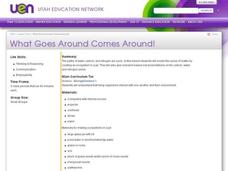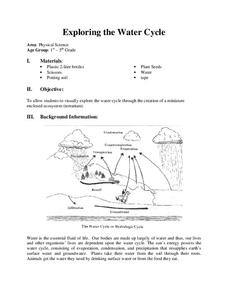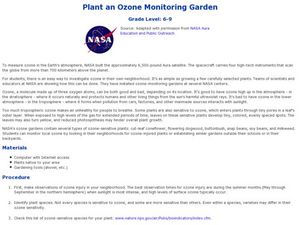Curated OER
Seasonal Cloud Cover Variations
Students, in groups, access data from the NASA website Live Access Server regarding seasonal cloud coverage and the type of clouds that make up the coverage. They graph the data and make correlations between types, seasons and percentages.
Curated OER
Greenhouse Effect- Online Interactive
In this greenhouse effect activity, students learn about Earth's climate change by reading a 7 paragraph text. Students then answer 10 questions. This is an online interactive activity.
Curated OER
Meteorites
Students model how meteors fall to the surface of planets. In this space science lesson plan, students identify different types of meteorites using an interactive online website. They investigate the relationship between a meteorite's...
Curated OER
What Causes the Seasons?
Students conduct experiment to examine how tilt of globe influences warming caused by lighted bulb. They monitor simulated warming of their city by sun in winter and in summer by using light bulb, interpret results, and submit lab report.
Curated OER
Clouds
Test your students' science and/or reading comprehension skills with this activity, which provides a page of information about clouds and cloud classification. Both an earth science teacher and a language arts teacher could use this...
Curated OER
Ocean Currents and Sea Surface Temperature
Young scholars use satellite data to explore sea surface temperature. They explore the relationship between the rotation of the Earth, the path of ocean current and air pressure centers. After studying maps of sea surface temperature and...
Curated OER
Nitrogen Cycle
Students identify the main concepts and ideas of the nitrogen cycle.
They review key concepts covered up to this point in ecology including food chains, food webs, energy pyramids, and bio-geochemical cycles.
Curated OER
What Goes Around Comes Around!
Students create an ecosystem in a jar to show a model of the water, carbon, and nitrogen cycle. Working in small groups, they research and present orally the information they find on this cycle.
Curated OER
Exploring the Water Cycle
Students investigate the water cycle. In this water cycle activity, students create an ecosystem within a 2-liter bottle. Students record scientific observations as they observe the water cycle within their ecosystem.
Curated OER
Clouds
Students explore clouds. In this weather lesson plan, students identify the steps in the water cycle, define condensation and evaporation, and relate this information to cloud formation. Students perform a cloud experiment,...
Curated OER
Modeling Hot and Cold Planets
Learners, in teams, design and construct models of two planets, one hot and the other cold, using a variety of materials. They attempt to create the models out of substances that will actually show the greatest temperature differences...
Curated OER
Biomes: The Threat of the Sea
Learners create posters to raise awareness about Global Warming as an immediate threat. In this environmental lesson, students respond to the video Biomes: The Threat of the Sea by researching global warming and making posters to...
Curated OER
Watch Me Grow
Students observe that plants need air, food, light, and water to survive. In this plant biology lesson, students observe the growth and development of two plants, one is the control plant and the other is denied either air, water,...
Curated OER
Plant an Ozone Monitoring Garden
Students create a garden. In this ozone lesson, students discuss ozone injury, identify plants sensitive to ozone, and then plant their own ozone garden.
Curated OER
Convection and Wind
Young scholars use water, beakers, hot plates, paper dots, and goggles to participate in a hands on activity where they see how a convection current creates wind. In this convection current lesson plan, students participate in a hands on...
Curated OER
Carbon Cycle Game
In this carbon cycle lesson, middle schoolers review the carbon cycle and visit stations in the room where they experience every phase in the carbon cycle. Students journal about their journey through the cycle and brainstorm ways...
Curated OER
Connection to Fine Arts: Carbon-Dating Masterpieces
In this carbon dating worksheet, students read about how carbon-14 is used to date historical paintings. They answer questions about carbon dating and its importance.
Curated OER
Fallout!
Students plot the locations of fallout from two disasters that polluted much of the world's air. They plot the ash fallout from the 1980 Mt. St. Helen's eruption to see what the wind patterns in the United States look like overall. Next...
Curated OER
Geographic Effects on Precipitation, Water Vapor and Temperature
Students investigate the factors affecting climate using Live Access Server. In this geography lesson plan, students graph atmospheric data using Excel spreadsheet. They compare and contrast temperature, precipitation and water vapor of...
Curated OER
Biomes: Extreme Climate
Learners discuss the causes of global warming. For this earth science lesson, students examine how global warming is connected to the arctic and world climate. They write a paragraph about their interconnection.
Curated OER
Global Warming – More or Less
Eighth graders identify the factors that contribute to global warming. In this earth science lesson, 8th graders evaluate the impact of global warming on the planet. They discuss their views within the group.
Curated OER
Recreating the Greenhouse Effect
Learners recreate the greenhouse effect. In this environmental science lesson, students gather materials and follow procedures to create the greenhouse effect on a small scale.
Curated OER
Trends of Snow Cover and Temperature in Alaska
Students compare NASA satellite data observations with student surface measurements of snow cover and temperature. They practice data collection, data correlations, and making scientific predictions.
Curated OER
TRANSPIRATION IN PLANTS
Young scholars define the hydrologic cycle, define transpiration, name the three parts of the hydrologic cycle, and record the amount of moisture given off by several green plants.

























